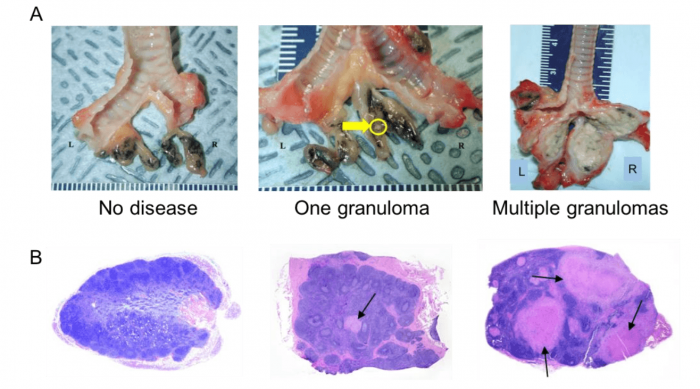
Tuberculosis is a disease generally associated with the lung. However, tuberculosis does not only affect the lungs. In fact, Mycobacterium tuberculosis (Mtb), the bacterium that causes tuberculosis, can infect any part of our body. After the lungs, the site that is most frequently infected are tiny lymphoid organs called lymph nodes.
Lymph node tuberculosis has been around for over 3,000 years. It is most commonly recognized as a lump on the neck called scrofula, but there are many lymph nodes within the lungs that cannot be seen. During medieval times, scrofula was called the “King’s Evil,” and was treated by a royal touch by kings. This method of treatment continued until the 18th century in England and even up to the 19th century in France. Though pulmonary tuberculosis and scrofula are parts of the same disease, this connection was still unknown several hundred years ago. Today, however, we know that Mtb is responsible for both disease manifestations.
Lymph nodes are small organs found throughout your body that house immune cells, such as T cells, that serve as sentinels waiting and watching for invading intruders like bacteria or viruses. Once an intruder is detected, the lymph nodes are a site where T cells specific for the pathogen are expanded and then sent out, like soldiers, to fight off the enemy. In tuberculosis, it is essential for Mtb to be transported to the lymph nodes that line the airways for our body to mount a defense against them. However, Mtb instead uses the lymph nodes as sites of refuge and growth, like an enemy in a Trojan horse. Armed with this knowledge, it is important to also target the lymph nodes when studying tuberculosis treatment efficacy and vaccine design.
Our laboratory studies tuberculosis in a non-human primate model because it faithfully mimics all aspects of human tuberculosis disease. In our study, we examined what happens when Mtb infects the lymph nodes of two different but closely related species of macaques. Rhesus macaques develop more severe pulmonary tuberculosis compared to cynomolgus macaques. Rhesus macaques also have a much more severe infection and pathology in the thoracic lymph nodes, that is, those in the vicinity of the lung (Fig 1). Although not all lymph nodes in macaques harbor Mtb, those that were infected contained numerous live bacteria, some even up to millions! We found that lymph nodes are a poor environment for killing Mtb and rhesus macaque lymph nodes are worse at killing than the cynomolgus macaques.
When Mtb gets carried into the lymph nodes, the body’s immune cells try to fight it and wall it off to prevent the bacteria from spreading. This results in structures called granulomas (Fig 2). For a lymph node to properly function, different immune cell populations need to be at specific sites to interact and communicate with each other. When a granuloma forms, it displaces these cell populations, effectively hindering their capacity to defend against the bacteria. Immune cells in Mtb-infected lymph nodes were also deficient in producing factors that help in killing Mtb. We found that as the granuloma increases in size, the number of bacteria also increases substantially.

Fig 2. Mtb infection results in granuloma formation and various degrees of destruction of lymph node structure. A. Lymph nodes without disease (left), with one small granuloma (middle) and enlarged with multiple converging granulomas (right). The yellow arrow is pointing to a granuloma. B. Microscopic photos of a lymph node that has no disease (left), with one granuloma (middle) and multiple granulomas (right). The black arrows are pointing to granulomas. Image republished with permission from PLOS from https://doi.org/10.1371/journal.ppat.1007337.
We used an anti-tuberculosis drug, linezolid, to measure the killing of Mtb in the lungs compared to lymph nodes. Linezolid reduced bacterial numbers in both sites, however, it was less effective in killing Mtb in the lymph nodes than in the lungs. Therefore, when testing new anti-tuberculosis drugs or vaccines, it is important to also examine Mtb death and survival in the lymph nodes.
All of our findings point to Mtb effectively hijacking the lymph nodes and using them as a niche for its growth. Since Mtb can grow and hide in lymph nodes, it is important that vaccines against tuberculosis prevent infection not only in the lungs but also in lymph nodes. Recognizing the contribution of lymph nodes to tuberculosis will help us understand the disease more completely and develop innovative ways to defeat it.









